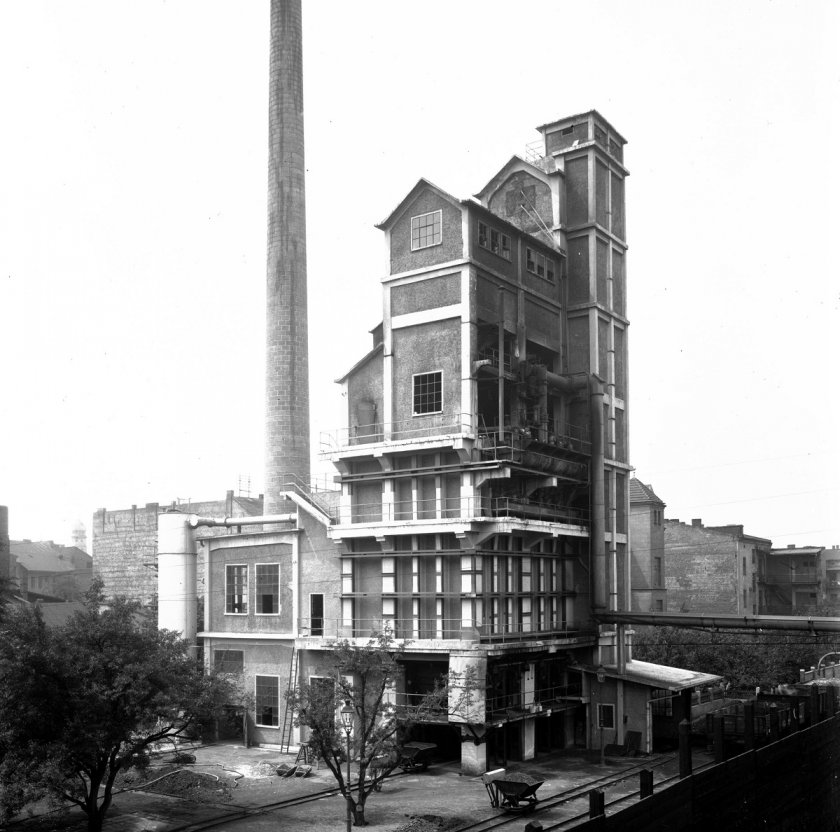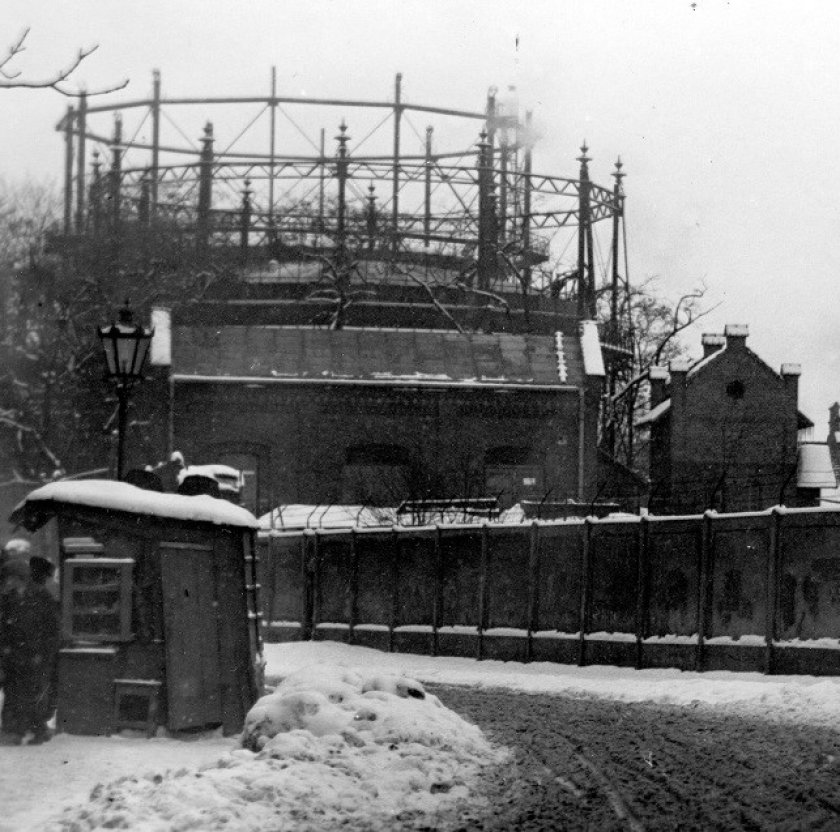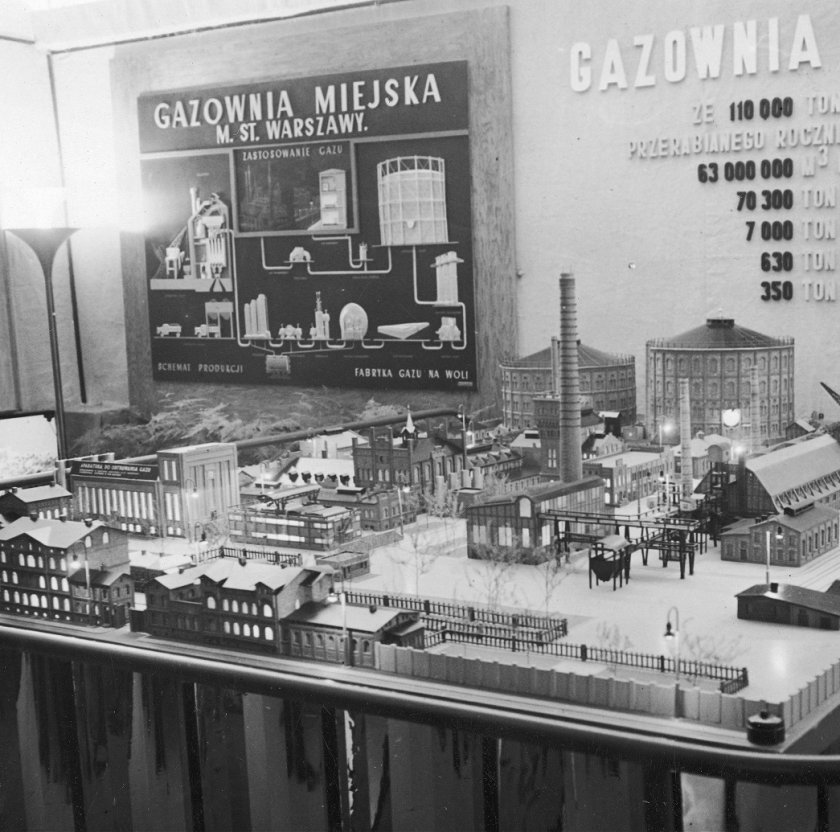History of the Stanisławów Gasworks
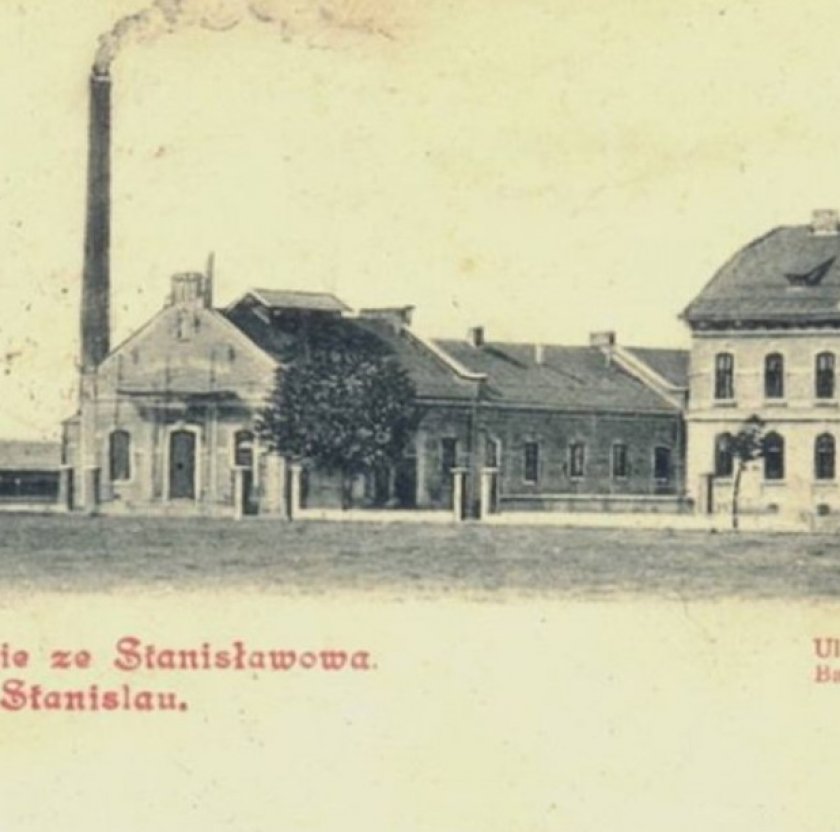 Fot.
Fot.
Situated in the fork of the Bystrzyca River, the town was founded by Andrzej Potocki in 1662, and took its original name from the name of the founder's first-born son. "Little Lviv", as it was sometimes called, was known for its many gardens, which made the city very friendly to its residents. Stanisławów was also famous for its gasworks, which was the major source of energy for the entire city for many decades.
The first gasworks in Stanisławów was opened in 1873, but it actually it started to operate a year later. Initially, the main customer for the gas produced there was the railway, which supplied the local station with gas energy. There was little gas consumption in other areas of the city.
Suffice it to say that until the 1890s the gasworks supplied energy to just 165 gas lamps installed in the midtown. With the industrial development of the city and the constantly growing population, the capacity of the gasworks turned out to be insufficient. By 1895, annual gas output had risen from an initial 50,000 to 165,000 cubic metres. Five years later, it was already 190,000 m3. According to Krzysztof Broński, the author of a monograph on Stanisławów, in that period the length of the city's gas pipelines was increased from 9 to 17.5 kilometres.
Suffice it to say that until the 1890s the gasworks supplied energy to just 165 gas lamps installed in the midtown. With the industrial development of the city and the constantly growing population, the capacity of the gasworks turned out to be insufficient. By 1895, annual gas output had risen from an initial 50,000 to 165,000 cubic metres. Five years later, it was already 190,000 m3. According to Krzysztof Broński, the author of a monograph on Stanisławów, in that period the length of the city's gas pipelines was increased from 9 to 17.5 kilometres.
The growing demand for gas meant that by the end of the 19th century, in the winter season, its supply was only able to provide light to half of the city's lamps.
These circumstances led the municipal authorities to build a new, more efficient gasworks. Before this happened, however, a discussion on the rationale of building a new plant was held at the City Council. According to some city councillors, a redevelopment of the old gasworks would be sufficient. Study tours by the then director of the gasworks, Antoni Dziurzyński, to the most modern European gasworks were intended to help in making the right decision. At the city's expense, Dziurzyński expanded his knowledge in Vienna and Zurich, as well as at the memorable 1900 Paris Exposition. His report convinced the councillors of the need for a new facility.
These circumstances led the municipal authorities to build a new, more efficient gasworks. Before this happened, however, a discussion on the rationale of building a new plant was held at the City Council. According to some city councillors, a redevelopment of the old gasworks would be sufficient. Study tours by the then director of the gasworks, Antoni Dziurzyński, to the most modern European gasworks were intended to help in making the right decision. At the city's expense, Dziurzyński expanded his knowledge in Vienna and Zurich, as well as at the memorable 1900 Paris Exposition. His report convinced the councillors of the need for a new facility.
The prevailing arguments concerned public safety. The old gasworks was located in the city centre, which was against the new building and sanitation law.
For the location of the new gasworks, plots of land located in the area known as the "Łan za Belwederem" were chosen. In 1901, a competition was announced for the design of a plant that would accommodate the increased production capacity (calculated at 2,000 cubic metres of fuel per day with the possibility of increasing it to 4,000 m3). The winning project was announced by the Vienna-based company Monaschek. Once the design of the gasworks was ready, a public competition was launched for its implementation, both in terms of construction and technology. Ultimately, the construction of the buildings was commissioned to the Schloss and Pfeffer company.
For the location of the new gasworks, plots of land located in the area known as the "Łan za Belwederem" were chosen. In 1901, a competition was announced for the design of a plant that would accommodate the increased production capacity (calculated at 2,000 cubic metres of fuel per day with the possibility of increasing it to 4,000 m3). The winning project was announced by the Vienna-based company Monaschek. Once the design of the gasworks was ready, a public competition was launched for its implementation, both in terms of construction and technology. Ultimately, the construction of the buildings was commissioned to the Schloss and Pfeffer company.
The project was scheduled for completion in June 1902, and the deadline was met. The technical equipment was installed in mid-1902.
Originally, the winner of the to execute this stage of the construction was the renowned Zieleniewskiego company from Kraków. However, before the installation work could begin, the municipal authorities decided, for cost-saving reasons, to withdraw from the services of the Kraków-based company, and the contract was handed over to the E. Bradt from Ottynia. The quality assessment of the works was supervised by the director of the Lviv gasworks, Adam Teodorowicz who, interestingly enough, began his professional career in the administration of the gasworks in Stanisławów. The contractor completed the investment in a very short time. In October, 1902 the gasworks was already standing and had the crucial equipment for gas production.
Originally, the winner of the to execute this stage of the construction was the renowned Zieleniewskiego company from Kraków. However, before the installation work could begin, the municipal authorities decided, for cost-saving reasons, to withdraw from the services of the Kraków-based company, and the contract was handed over to the E. Bradt from Ottynia. The quality assessment of the works was supervised by the director of the Lviv gasworks, Adam Teodorowicz who, interestingly enough, began his professional career in the administration of the gasworks in Stanisławów. The contractor completed the investment in a very short time. In October, 1902 the gasworks was already standing and had the crucial equipment for gas production.
The following months were devoted to the construction of the chimney and the concrete pool, which were carried out by two companies: the Schleyen brothers (a subsidiary of a Viennese company based in Lviv) and Zuliani Giovanni from Lviv. In 1902, the modern plant was put into operation. Its ceremonial start-up took place on 27 December.
The new investment proved to be the right decision. The capacity of the gasworks increased several-fold, which translated into the use. In 1910, the capacity was already around 455,000 cubic metres of gas a year, the vast majority of which was used for private purposes. Gas consumption in 1910 is clearly illustrated in the graph opposite.
The new investment proved to be the right decision. The capacity of the gasworks increased several-fold, which translated into the use. In 1910, the capacity was already around 455,000 cubic metres of gas a year, the vast majority of which was used for private purposes. Gas consumption in 1910 is clearly illustrated in the graph opposite.
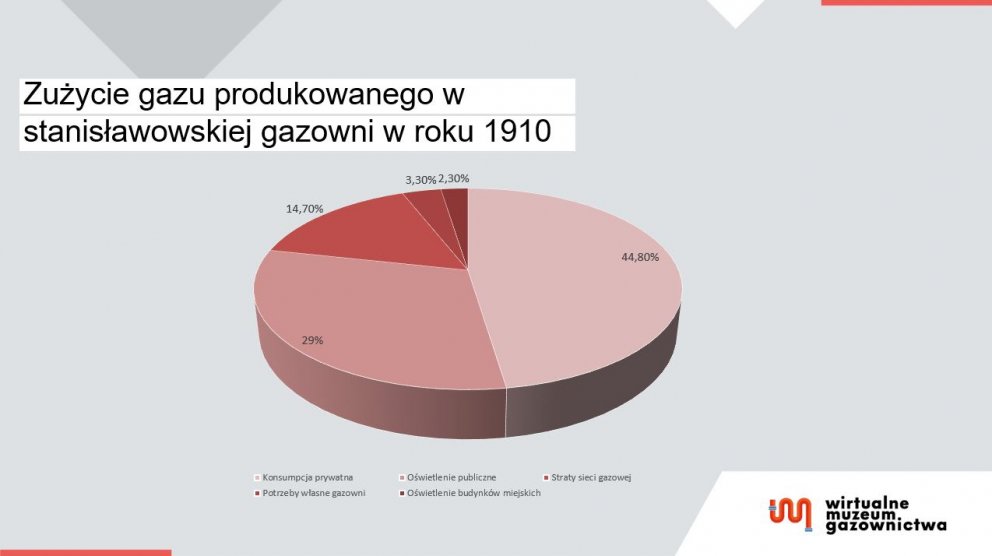
Consumption of gas produced at the Stanisławów gasworks in 1910. Based on: K. Broński,
Rozwój społeczno-gospodarczy Stanisławowa w latach 1867-1939, Kraków 1999.
In 1910, the gas network in Stanisławów was already more than 25 kilometres long. Moreover, it is worth mentioning that 2349 gas meters were installed in Stanislawów by 1916, which shows the scale of interest in accessing energy from gas. In 1912, a decision was taken by the municipal authorities to carry out another crucial modernisation of the gasworks. At that time, the oil-powered apparatus was replaced with coal-powered machinery.
This decision was motivated by economic considerations. The costs for the reconstruction and subsequent extensive modernisation of the plant was 464,000 crowns. The funds for this vast investment came largely from long-term loans. They were borrowed from, e.g., the Galician National Bank (amounting to 340,000 crowns) and Kasa Oszczędności Miasta Stanisławowa [Savings Bank of Stanisławów] (196,000 crowns).
This decision was motivated by economic considerations. The costs for the reconstruction and subsequent extensive modernisation of the plant was 464,000 crowns. The funds for this vast investment came largely from long-term loans. They were borrowed from, e.g., the Galician National Bank (amounting to 340,000 crowns) and Kasa Oszczędności Miasta Stanisławowa [Savings Bank of Stanisławów] (196,000 crowns).
Engineer Antoni Dziurzynski was the long-time director of the Stanisławów gasworks. He gained recognition in Stanisławów not only as an excellent administrator of the gasworks but also as a popularizer of knowledge about the use and properties of natural gas and the benefits of its use.
He enjoyed genuine esteem among the people of Stanislawow and a reputation as a great expert in engineering matters. He was involved not only in issues related to gasworks and gas, but also to the city infrastructure which were very important to the old Stanisławów. For example, in February 1910 he held a lecture at the Polytechnic Society on the construction of an electric tramway in the city.
He enjoyed genuine esteem among the people of Stanislawow and a reputation as a great expert in engineering matters. He was involved not only in issues related to gasworks and gas, but also to the city infrastructure which were very important to the old Stanisławów. For example, in February 1910 he held a lecture at the Polytechnic Society on the construction of an electric tramway in the city.
The lecture was widely commented on by the local community, as Dziurzyński questioned the need for a municipal "electric railway", while at the same time bringing up the need to expand the water and sewage networks.
The municipal gasworks was the only source of energy for Stanisławów until the end of the 1920s, when a power plant was set up in the town. It should be noted that Stanisławów was one of the few Polish towns that had to wait so long to have its own power plant. As it turns out, however, this was a fully conscious decision by the city's authorities, which decided before World War I that the modern gasworks in Stanisławów would fully satisfy the needs of the city's inhabitants for energy supplies.
The municipal gasworks was the only source of energy for Stanisławów until the end of the 1920s, when a power plant was set up in the town. It should be noted that Stanisławów was one of the few Polish towns that had to wait so long to have its own power plant. As it turns out, however, this was a fully conscious decision by the city's authorities, which decided before World War I that the modern gasworks in Stanisławów would fully satisfy the needs of the city's inhabitants for energy supplies.
Similar opinions were expressed just after Poland regained independence. Therefore, it is surprising that already in 1919 (despite the destruction inflicted by the Russians during World War I) the production capacity of the gasworks was over 700,000 cubic metres.
By the time the power station opened, gas consumption in Stanisławów had reached 1,390,000 m3. In conclusion, it is worth noting that gas was the primary fuel used to power the generating engines at the Stanisławów power station, which opened in 1930. The choice of this type of fuel for the power plant was dictated by the fact that there were rich natural gas deposits in the Stanisławów area. Especially in the Dashava area, where extraction was carried out by the State Mineral Oil Plant "Polmin".
By the time the power station opened, gas consumption in Stanisławów had reached 1,390,000 m3. In conclusion, it is worth noting that gas was the primary fuel used to power the generating engines at the Stanisławów power station, which opened in 1930. The choice of this type of fuel for the power plant was dictated by the fact that there were rich natural gas deposits in the Stanisławów area. Especially in the Dashava area, where extraction was carried out by the State Mineral Oil Plant "Polmin".
The 1930s marked the beginning of a difficult period for the Stanisławów gasworks. Competition from electricity was fierce. At that time, the number of gas consumers also fell by 20 per cent, compared to the period before the power plant became operational. During the years of German occupation of the city, the use of gas for lighting was banned. In 1953, the Ukrainian authorities decided to modernise the gasworks. This investment was aimed at a complete switchover to the use of natural gas, which happened two years later.
